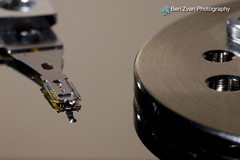 Last week, I had a hard drive die. In the past, this has been an earth-shattering event.
Last week, I had a hard drive die. In the past, this has been an earth-shattering event.
When I bought my new computer last spring, I made three major hardware decisions. The first was to get the most future-proof, powerful machine I could afford. The second was to equip it with RAID. The third was to invest in multiple, external drives for incremental backups made by Apple's Time Machine.
The first decision doesn't really come into effect here except that everything that follows the failure happened much quicker than it would have otherwise.
When a drive fails, you loose all the data stored on it, that's just the way it goes. The beauty of RAID 5 is that you can lose any one hard drive and keep all your data because it is stored redundantly. There is a very convenient function of binary math called XOR that is used by RAID 5 arrays. Basically, if you XOR all the bits in the same spot on each drive together, you get 1 (or is it zero? I can never remember.) So if one drive dies, you know that the bit stored in that spot on the drive is whatever results in 1 with an XOR opperation. As a result, when my drive failed I got a notice from the RAID controller that I was down one drive, but everything was otherwise pretty okay.
At some point, I rebooted my machine, I don't remember why. When it came back up, the RAID controller no longer seemed to think that drive was back. "Great," I thought "I'll just throw it back in the group and rebuild it." In the mean time, I was copying data between two remote web servers, and installing Parallels Desktop to make it easier to take a class from home next week. As it turns out, the current version of Parallels for Mac is not compatible with something on my machine and caused a kernel panic. That's like the Blue Screen of Death, but for Macs. You almost never see them... really.
Rebooting again, I found that my RAID controller no longer felt that it had a valid array, and that the one bad drive was preventing my machine from booting at all. Once I removed the bad drive, told the RAID controller to create a new array, and created a new filesystem on the remaining three drives. I used the Mac OS install disk to restore my system from my last known good backup on the external drive.
The moral of the story was best summed up by my friend Rick: If you're paranoid, you only have to be right once to make it worthwhile. If you always assume the best, then you have to be right every time. Two bad failures in a row + zero data loss = a happy Ben.
-Photograph of dead hard drive, by Ben Zvan Photography
Facebook | Twitter | Reddit | Stumble
blog comments powered by Disqus
Comics
AppleGeeks
The Awkward Yeti
Chainsawsuit [new!]
Ctrl+Alt+Del
Doghousediaries
Doonesbury
Formal Sweatpants
FoxTrot
Happle Tea [new!]
Hyperbole and a Half
Indexed
Joy of Tech
Kate or Die!
Lunarbaboon
Our Valued Customers
RealLife
Romantically Apocalyptic
Saturday Morning Breakfast Cereal
Scenes From A Multiverse [new!]
A Softer World
Sci-ence
Sinfest
Three Panel Soul
Wondermark
XKCD
Blogs
Almost Diamonds Antihero As I See It Black and WTF Caerwyn Farm and Spirits The Catty Life Domestic Sluttery Engrish For Goodness Sake Gizmodo Greg Laden Le Zèbre Bleu Lefse and Kimchee Lifehacker Light-test Linux in Exile Man Bytes Blog Photography is Not a Crime Post Secret Photoshop Disasters
Arts
New Pictures 8: Sarah Jones
Minneapolis Institue of Arts
04/18/2013—02/02/2014 - Free
31 Years: Gifts from Martin Weinstein
Minneapolis Institue of Arts
11/02/2013—08/31/2014 - Free
New Pictures 9: Rinko Kawauchi
Minneapolis Institue of Arts
02/20/2014—08/10/2014 - Free
Finland: Designed Environments
Minneapolis Institue of Arts
05/10/2014—08/17/2014 - Free
Music
Nick Cave and the Bad Seeds
at State Theatre
06/21/2014 \ Doors 8:00pm
Please wait while my tweets load